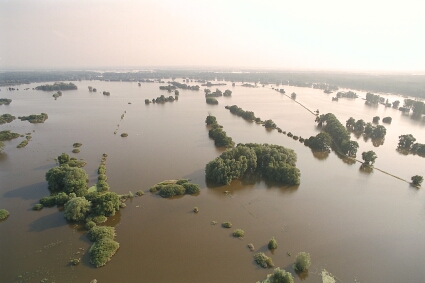Determining potential nutrient retention rates as an ecosystem service in riparian zones – AZOTE
Project management: Dr. Mathias Scholz, Dr. Christiane Schulz-Zunkel
Project staff: Ute Susanne Kaden, dr. Mathias Scholz, Dr. Christiane Schulz-Zunkel, Dr. Holger Rupp
Cooperation:
BfG - German Federal Institute of Hydrology, Koblenz,
Department Bodenphysik - Arbeitsgruppe Monitoring und Skalierung von Transportprozessen (UFZ Halle)
Project duration: 2016 to 2019
Project description

It is necessary to find measures for reduction in water bodies due to high nitrate concentrations in rivers. Besides diffuse inputs of agriculture and point sources such as wastewater discharges and industry, self-cleaning ability of water bodies and their adjoining floodplains determines the nitrate concentration. A natural reduction is mainly controlled by microbial denitrification that, under anaerobic conditions, helps reduce nitrate to nitrite, followed by nitrogen monoxide, nitrous oxide and ultimately into molecular nitrogen.
Due to frequently water-saturated soils, stream riparian zones have the ability to remove nitrate from river floodplain systems based upon the carbon and nitrate availability along with the long hydraulic retention time. However, the controlling factors and the dimension of nitrate degradation potential are still largely unknown. The reason for this is (1) the high complexity of the denitrification process with a large number of possible influencing factors and (2) the high spatial and temporal heterogeneity of influencing factors.

The project AZOTE aims for representative field sampling campaign in riparian zones at four rivers in Germany, i.e., Elbe, Rhine, Main, and Weser. Sampling takes place in strata representing the flood gradient. The potential denitrification enzyme activity of the soil samples is determined experimentally by acetylene inhibition.
The statistical correlations between spatial and physicochemical parameters of the soil shall be identified, along with the experimentally determined results, based on the results of the acetylene inhibition. Special attention is paid to those parameters that are widely available and hence can be used directly or indirectly via proxies to estimate the level of self-purification of floodplains. Based on the identified statistical correlations, model-based prediction of the denitrification capacity of entire floodplains should be optimized. In order to assess the societal benefits of the purification performance as an ecosystem service of floodplains, it is finally subjected to an economic evaluation.
Important objectives of the project
- Determination of the denitrification capacity in floodplains of different hydro-geomorphological units, which are representative for active floodplains of federal waterways namely Elbe, Rhine, Main, and Weser.
- Analysing the effects of hydrological parameters (i.e. flood duration, connectivity) and soil parameters (i.e. soil type, soil organic matter, pH, temperature) as well as topography on potential denitrifications rates.
- Validation, adaptation and extension of the existing thumb-rule approach by Schulz-Zunkel et al. (2012) and Horchler et al. (2015).
- Development of a denitrification model in the context of ecosystem services.
- Evaluating the potential of purification through denitrification as an ecosystem service.
